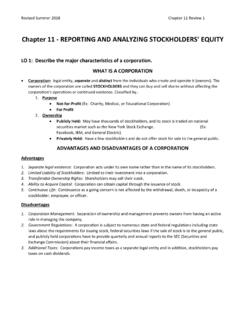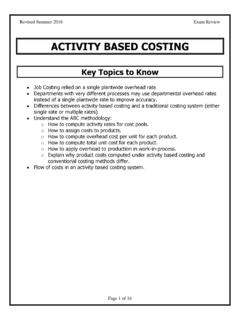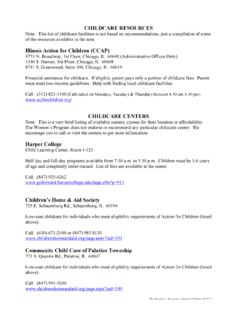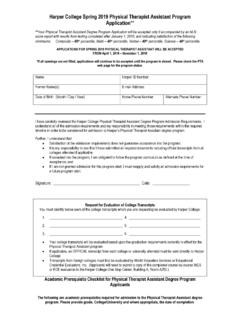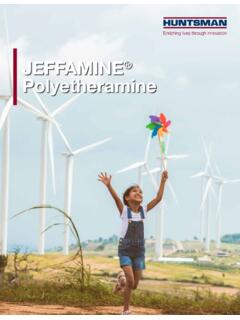Transcription of Chapter 11 Questions Multiple Choice
1 Chapter 11 Question Review 1 Chapter 11 Questions Multiple Choice 1. Two classifications appearing in the paid-in capital section of the balance sheet are a. preferred stock and common stock. b. paid-in capital and retained earnings. c. capital stock and additional paid-in capital. d. capital stock and treasury stock. 2. A disadvantage of the corporate form of organization is a. professional management. b. tax treatment. c. ease of transfer of ownership. d. lack of mutual agency. 3. Alt Corp. issues 5,000 shares of $10 par value common stock at $14 per share. When the transaction is recorded, credits are made to: a. Common Stock $50,000 and Paid-in Capital in Excess of Stated Value $20,000. b. Common Stock $70,000. c. Common Stock $50,000 and Paid-in Capital in Excess of Par Value $20,000. d. Common Stock $50,000 and Retained Earnings $20,000. 4. If common stock is issued for an amount greater than par value, the excess should be credited to a.
2 Cash. b. Retained Earnings. c. Paid-in Capital in Excess of Par Value. d. Legal Capital. 5. Stock dividends and stock splits have the following effects on retained earnings: Stock Splits Stock Dividends a. Increase No change b. No change Decrease c. Decrease Decrease d. No change No change 6. Which one of the following events would not require a journal entry on a corporation s books? a. 2-for-1 stock split. b. 100% stock dividend. c. 2% stock dividend. d. $1 per share cash dividend. 7. The term legal capital is a descriptive term for a. stockholders equity. b. par value. c. residual equity. d. market value. Chapter 11 Question Review 2 8. The board of directors of Yancey Company declared a cash dividend of $ per share on 42,000 shares of common stock on July 15, 20X1. The dividend is to be paid on August 15, 20X1, to stockholders of record on July 31, 20X1.
3 The correct entry to be recorded on August 15, 20X1, would be a. Dividends Payable 63,000 Cash 63,000 b. Cash Dividends 63,000 Cash 63,000 c. Cash 63,000 Paid-in Capital 63,000 d. Dividends Payable 63,000 Paid-in Capital 63,000 9. On January 1, Ripken corporation had 80,000 shares of $10 par value common stock outstanding. On May 11 the company declared a 10% stock dividend to stockholders of record on May 25. Market value of the stock was $13 on May 11. The entry to record the transaction of May 11 would include a a. debit to Stock Dividends for $104,000. b. credit to Cash for $104,000. c. credit to Common Stock Dividends Distributable for $104,000. d. credit to Common Stock Dividends Distributable for $24,000. 10. The amount of stock that may be issued according to the corporation s charter is referred to as the a. authorized stock. b. issued stock. c.
4 Unissued stock. d. outstanding stock. 11. Dividends in arrears are dividends on a. cumulative preferred stock that have been declared but have not been paid. b. non-cumulative preferred stock that have not been declared for a given period of time. c. cumulative preferred stock that have not been declared for a given period of time. d. common dividends that have been declared but have not yet been paid. 12. Outstanding stock of the Bush corporation included 40,000 shares of $5 par common stock and 20,000 shares of 5%, $10 par non-cumulative preferred stock. In 20X1, Bush did not declare or pay any dividends. In 20X2, Bush declared and paid dividends of $24,000. How much of the 20X2 dividend was distributed to preferred shareholders? a. $14,000. b. $18,000. c. $10,000. d. $20,000 Chapter 11 Question Review 3 13. Outstanding stock of the Bush corporation included 40,000 shares of $5 par common stock and 20,000 shares of 5%, $10 par cumulative preferred stock.
5 In 20X1, Bush did not declare or pay any dividends. In 20X2, Bush declared and paid dividends of $24,000. How much of the 20X2 dividend was distributed to preferred shareholders? a. $14,000. b. $18,000. c. $10,000. d. $20,000 14. Which of the following is not true of a corporation ? a. It may buy, own, and sell property. b. It may sue and be sued. c. The acts of its owners bind the corporation . d. It may enter into binding legal contracts in its own name. 15. Tomlinson Packaging corporation began business in 2017 by issuing 50,000 shares of $5 par common stock for $8 per share and 5,000 shares of 6%, $10 par preferred stock for par. At year end, the common stock had a market value of $10. On its December 31, 2017 balance sheet, Tomlinson Packaging would report a. Common Stock of $500,000. b. Common Stock of $250,000. c. Common Stock of $400,000. d. Paid-in Capital of $330,000. Chapter 11 Question Review 4 EXERCISES 1.
6 Identify (by letter) each of the following characteristics as being an advantage or a disadvantage of the corporate form of business or not applicable to the corporate form of business organization. A = Advantage D = Disadvantage N = Not Applicable Characteristics _____ 1. Separate legal entity _____ 2. Taxable entity resulting in additional taxes _____ 3. Continuous life _____ 4. Unlimited liability of owners _____ 5. Government regulation _____ 6. Separation of ownership and management _____ 7. Ability to acquire capital _____ 8. Ease of transfer of ownership 2. On January 1, 20X1, Wooden Company issued 16,000 shares of $2 par value common stock for $120,000. On March 1, 20X1, the company purchased 2,000 shares of its common stock for $15 per share for the treasury. Journalize the stock transactions of Wooden Company in 20X1. Date Debit Credit Chapter 11 Question Review 5 3.
7 In its first year of operations, Martinez corporation had the following transactions pertaining to its $10 par value preferred stock. Feb. 1 Issued 8,000 shares for cash at $24 per share. July 1 Issued 6,000 shares for cash at $25 per share. (a) Journalize the transactions. (b) Indicate the amount to be reported for (1) preferred stock, and (2) paid-in capital in excess of par value preferred stock at the end of the year. Date Debit Credit Chapter 11 Question Review 6 4. The huntsman corporation has the following stockholders equity accounts: Preferred Stock Paid-in Capital in Excess of Par Value Preferred Stock Common Stock Paid-in Capital in Excess of Stated Value Common Stock Retained Earnings Treasury Stock Common Classify each account using the following tabular alignment. (Put an X in the correct column) 5. The corporate charter of Torres corporation allows the issuance of a maximum of 4,000,000 shares of $1 par value common stock.
8 During its first three years of operation, Torres issued 2,080,000 shares at $15 per share. It later acquired 80,000 of these shares as treasury stock for $25 per share. Based on the above information, answer the following Questions : (a) How many shares were authorized? (b) How many shares were issued? (c) How many shares are outstanding? (d) What is the balance of the Common Stock account? (e) What is the balance of the Treasury Stock account? Paid-in Capital Account Capital Stock Additional Retained Earnings Other Preferred Stock Paid-in Capital in Excess of Par Value Preferred Stock Common Stock Paid-in Capital in Excess of Stated Value Common Stock Retained Earnings Treasury Stock Common Chapter 11 Question Review 7 6. On January 1, 20X1, Browning corporation had 75,000 shares of $1 par value common stock issued and outstanding. During the year, the following transactions occurred: Mar.
9 1 Issued 90,000 shares of common stock for $675,000 June 1 Declared a cash dividend of $ per share to stockholders of record on June 15 June 30 Paid the $ cash dividend Dec. 1 Purchased 5,000 shares of common stock for the treasury for $18 per share Dec. 15 Declared a cash dividend on outstanding shares of $ per share to stockholders of record on December 31 Net income for 20X1 amounted to $951,000. Prepare journal entries to record the above transactions. Date Debit Credit Chapter 11 Question Review 8 7. On October 31 the stockholders' equity section of Eaton Company's balance sheet consists of common stock $600,000 and retained earnings $400,000. Eaton is considering the following two courses of action: (1) declaring a 10% stock dividend on the 60,000 $10 par value shares outstanding or (2) a 2-for-1 stock split.
10 The current market price is $15 per share. Instructions Prepare a tabular summary of the effects of the alternative actions on the company's stockholders' equity and outstanding shares. Use these column headings: Before Action, After Stock Dividend, and After Stock Split. After After Before Stock Stock Action Dividend Split Stockholders' equity Paid-in capital Common stock $600,000 In excess of par value 0 Total paid-in capital 600,000 Retained earnings 400,000 Total stockholders' equity $1,000,000 Outstanding shares 60,000 Par value per share $ Chapter 11 Question Review 9 Chapter 11 Solutions Multiple Choice Solutions 1. C 2. B 3. C 4. C 5. B 6. A 7. B 8. A 9. A 10. A 11. C 12. C 13. D 14. C 15.
